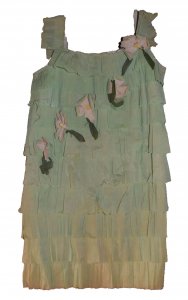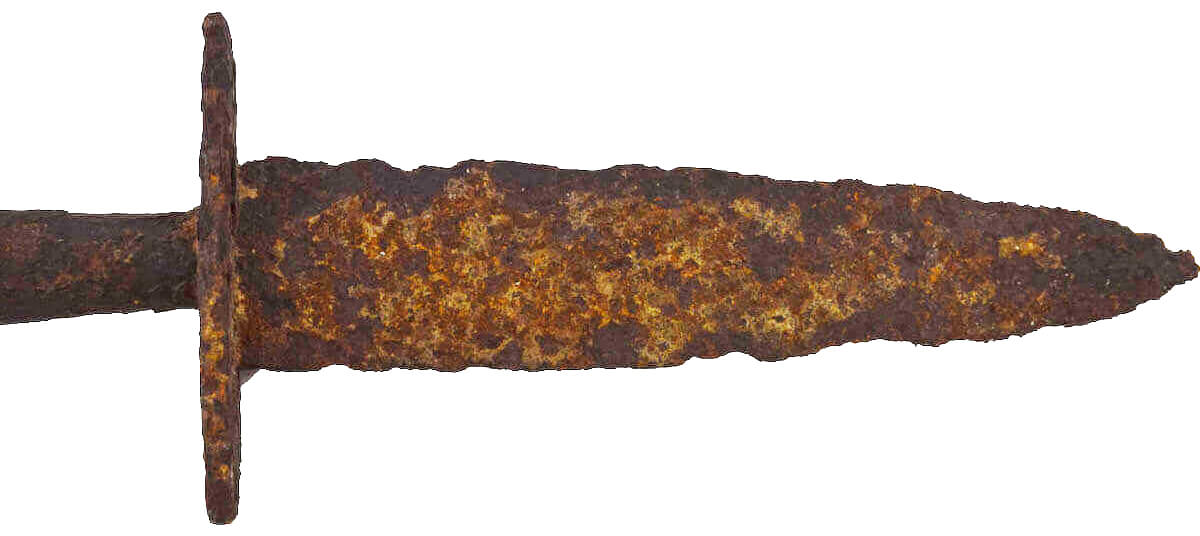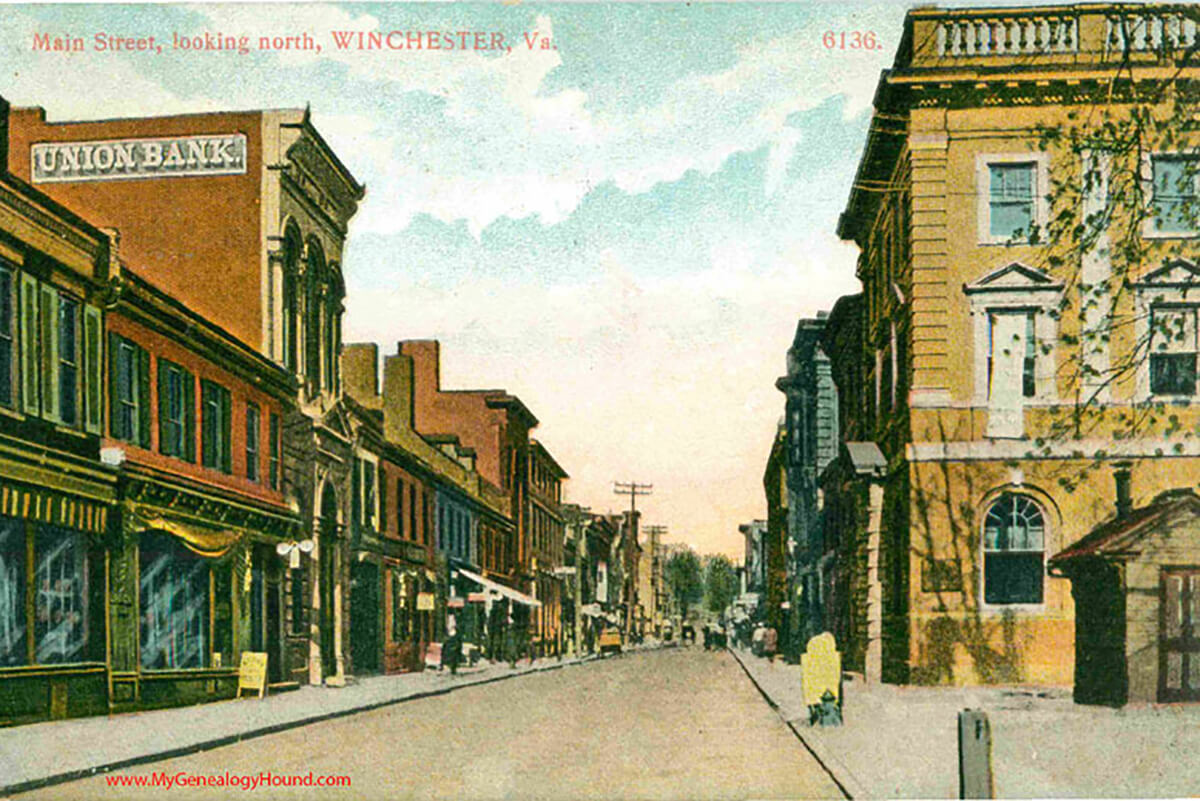A group of Shenandoah University history majors are set to be published authors this year for their work on a book commemorating the 275th anniversary of the founding of Winchester, Virginia.
The history students are using artifacts to help tell the city’s story in a book to be published by the Winchester-Frederick County Historical Society and co-edited by Shenandoah’s McCormick Civil War Institute Director Jonathan Noyalas ’01, M.A. (Shenandoah’s main campus has been located in Winchester since 1960.)
Noyalas said he suggested the book’s creation as an item to leave behind for future generations. And, it’s a project that allows the historical society to achieve a goal of further interaction with the university.

Dress crafted for an early Shenandoah Apple Blossom Festival.
The book will tell the city’s story through short explorations of 50 artifacts chosen by Noyalas and the historical society’s director, Cissy Shull. The book is intended for general audiences, with the artifacts, their importance, and their connection to Winchester’s history described in approximately 1,000-word essays, Noyalas said.
The writers & their artifacts
Kim Oliveto ’20 is writing about a lock of George Washington’s hair and a Quaker marriage certificate. Washington, the nation’s first president, worked as a surveyor in the Winchester area prior to the American Revolution, was elected to his first office from the city, and oversaw the construction of Fort Loudoun, which sat where North Loudoun Street is today. Even so, Oliveto noted that it’s unclear how exactly the lock of the nation’s first president’s light auburn hair ended up in Winchester.
Winchester, the first city west of the Blue Ridge Mountains to be settled by European immigrants and their descendants, has a longstanding Quaker community. Oliveto said certificates, like the one she is researching, were how American Quakers proved that they had married. In her piece, she is also explaining why Quakers relocated to the area from Pennsylvania.
Sarah Powell ’19 is telling a story of immigration and business development by focusing on a mortar and pestle used by early German immigrant Godfrey Miller. The family business grew to include dry goods as well as an apothecary, which was once the longest continuously operating drugstore in the nation. Miller’s apothecary is now on display at Shenandoah University’s Bernard J. Dunn School of Pharmacy.
Shelby Sprague ’22 is exploring Fort Loudoun and the French & Indian War. Steven Stabler ’22 is focusing on 20th-century history through a Korean War uniform, a World War II Purple Heart awarded to one of the first Winchester residents to die in the conflict, and a grouping of artifacts connected to Admiral Richard E. Byrd’s Antarctic expeditions. Through his artifacts, he’ll tell stories about how the city’s residents felt about war, as well as discuss the development of science and technology through the 20th century.

The artifact handled by Zach Thompson ’19 is a chest, owned by James Mason, a mid-19th-century U.S. senator who authored the Fugitive Slave Law in conjunction with the Compromise of 1850. The chest was part of Mason’s baggage when he was captured during the Civil War, along with Louisiana politician John Slidell, in what came to be known as the Trent Affair. Some of the story he will focus on includes the last-ditch efforts of the republic’s political leaders to keep the nation united during the tumultuous decade of the 1850s.
Jessica Kronenwetter ’20, who also photographed the artifacts for the book, is focusing on two areas. One allows her to talk about the Devil Diarists of Winchester, who were Confederate sympathizers who went to sometimes scandalous lengths to irritate Union troops during the Civil War. She will write about the many times Winchester changed hands, how the city’s women felt during the conflict, and how Union soldiers were perceived in the city. Her other area of focus allows her to explore the work of Frank Turgeon, a prominent aerial photographer and pilot who worked with National Geographic in the early 20th century.
Noyalas is also writing about a couple of artifacts. The Orrick Cemetery gravestone of Edward Hall, who served in the 30th United States Colored Troops during the Civil War, allows him to discuss racism, slavery and the 167 African Americans from Winchester who served with the Union Army during the Civil War. Additionally, he’s writing about a rifle presented by a group of Union veterans to Confederate veterans in Winchester in 1888 as an act of reconciliation – one that he said appears to have been unique in the post-Civil War south.
All told, Shenandoah faculty, alumni and students are writing about approximately half of the artifacts featured in the book, Noyalas said.
Becoming published authors
Sprague said being part of such a project, particularly as a freshman, is an honor. She said her friends at other colleges and universities don’t have such an opportunity available to them. And, the writing and research “gives me a better understanding of why I want to be a history major,” she said, noting that, at 19 years of age, she’ll be a published author.
The writing and research is providing the student authors with a unique extracurricular opportunity, said Oliveto, a grandmother who never thought a chance to be published would “happen to little ’ol me from Winchester, Virginia.” She’s loved the thrill of digging for information, and she said her experience in the history program shows that “It’s never too late to go back to college. Pick the right college and you can be published, whether you’re a freshman or a grandma.”
“We’ve gotten to showcase our talents to people outside of Shenandoah and prove our worth as prospective historians,” Kronenwetter said of the book project.
The book’s launch
Noyalas said that the hope is that the book will pique readers’ curiosity and inspire them to visit local museums or read more in-depth histories of Winchester and its demographically diverse population.
The book will be released in mid-October, Noyalas said, with the release celebrated during a special event on campus, with some of the artifacts available for viewing at the event.
Order “A Prominent Place”: Winchester’s 275 Years in 50 Artifacts
Photo credits: Jessica Kronenwetter ’20 and https://www.mygenealogyhound.com/




